Mechanical Properties of Refined A356 Alloy in Response to Continuous Rheological Extruded Al-5Ti-0.6C-1.0Ce Alloy Prepared at Different Temperatures
Abstract
1. Introduction
2. Materials and Methods
2.1. Materials
2.2. Sample Testing and Characterization
3. Result and Discussion
3.1. Refinement Effect of Master Alloys with Different Preparation Temperatures
3.2. Effect of Temperature Change on Al-Ti-C-Ce Microstructure
3.3. Effect of Heat Treatment and Ce on Eutectic Silicon Morphology
4. Conclusions
- With the increasing preparation temperature, the TiAl3 phase in the Al-Ti-C-Ce master alloy changed from blocks to a long strip; the Ti2Al20Ce phase changed from the large blocks to the smaller ones, combined with the more uniform distribution of the TiC phase. The morphology of the refinement phase is changed, and the distribution is more uniform, which can provide more nucleation sites for α-Al and promote the grain refinement of the A356 alloy;
- As the preparation temperature of Al-Ti-C-Ce increased, the grain size and eutectic Si length of A356 alloy decreased first and then increased. The peak grain size and eutectic length were 179.7 and 17.82 μm, respectively, at the preparation temperature of 1050 °C;
- The Al-Ti-C-Ce grain refiner addition can significantly improve the mechanical properties of the A356 alloy. With the increase of preparation temperature, the ultimate tensile strength and elongation of A356 alloy changed non-monotonically, and the peak values were 282.216 MPa and 3.9% at Al-Ti-C-Ce preparation temperatures of 1050 °C and 950 °C, respectively. In addition, the preparation of the grain refiner by CRE technology provides a new idea for the coupling of a subsequent grain refiner and continuous rheological extrusion on A356.
Author Contributions
Funding
Data Availability Statement
Acknowledgments
Conflicts of Interest
References
- Jiao, X.Y.; Liu, C.F.; Guo, Z.P.; Tong, G.D.; Ma, S.L.; Bi, Y.; Zhang, Y.F.; Xiong, S.M. The characterization of Fe-rich phases in a high-pressure die cast hypoeutectic aluminum-silicon alloy. J. Mater. Sci. Technol. 2020, 51, 54–62. [Google Scholar]
- Jiang, J.F.; Liu, Y.Z.; Xiao, G.F.; Wang, Y.; Xiao, X.Q. Effects of Temperature and Time on Microstructural Evolution of Semisolid 5A06 Aluminum Alloy: Preparation of Semisolid Billets in Ellipsoid Solid Phase. J. Mater. Eng. Perform. 2020, 29, 5346–5359. [Google Scholar]
- Limmaneevichitr, C. Fading mechanism of grain refinement of aluminum-silicon alloy with Al-Ti-B grain refiners. Mater. Sci. Eng. A 2003, 349, 197–206. [Google Scholar]
- Hanieh, A.; Salman, N.; Roohollah, J. Effects of Ti particles and T6 heat treatment on the microstructure and mechanical properties of A356 alloy fabricated by compocasting. Mater. Sci. Eng. A 2021, 818, 141443. [Google Scholar]
- Zhang, Y.; Ji, S.; Fan, Z. Improvement of mechanical properties of Al-Si alloy with effective grain refinement by in-situ integrated Al-2.2Ti-1B-Mg refiner. J. Alloys Compd. 2017, 710, 166–171. [Google Scholar]
- Tang, P.; Li, W.F.; Wang, K.; Du, J.; Chen, X.Y.; Zhao, Y.J.; Li, W.Z. Effect of Al-Ti-C master alloy addition on microstructures and mechanical properties of cast eutectic Al-Si-Fe-Cu alloy. Mater. Des. 2017, 115, 147–157. [Google Scholar]
- Ding, W.W.; Chen, T.L.; Zhao, X.Y.; Xu, C.; Tang, X.C.; Qiao, J.S. Effect of CeO2 on Microstructure and Synthesis Mechanism of Al-Ti-C Alloy. Materials 2018, 11, 2508. [Google Scholar]
- Lakshmi, R.N.; Rainer, H. Rapid solidification of hypoeutectic aluminum copper alloys using fast-scanning calorimetry. J. Alloys Compd. 2022, 925, 166829. [Google Scholar]
- Wang, J.H.; Zhu, J.Q.; Liu, Y.; Peng, H.P.; Su, X.P. Effect of spheroidization of eutectic Si on mechanical properties of eutectic Al-Si alloys. J. Mater. Res. 2018, 33, 1773–1781. [Google Scholar]
- Zhang, L.; Zhou, W.; Hu, P.H.; Zhou, Q. Effect of Al-3Nb-1B Master Alloy on the Grain Refinement of AZ91D Magnesium Alloy. Metall. Mater. Trans. B 2016, 47, 1999–2004. [Google Scholar]
- Wang, H.F.; An, Y.K.; Xu, X.; Guo, X.; Hu, Y. Rapid solidification microstructure evolution and grain refinement of deeply undercooled nickel alloys. Mater. Charact. 2020, 170, 110703. [Google Scholar] [CrossRef]
- Liu, X.F.; Zhang, Z.G.; Gao, Z.; Bian, X.F. The influence of electromagnetic stirring on Al-Ti-B master alloys. JOM 2000, 52, 47–48. [Google Scholar]
- Zhao, J.T.; Wu, X.Y.; Ning, L.P.; Zhang, J.J.; Han, C.; Li, Y.L. Wetting of aluminium and carbon interface during preparation of Al-Ti-C grain refiner under ultrasonic field. Ultrason. Sonochem. 2021, 76, 105633. [Google Scholar] [CrossRef] [PubMed]
- Liu, Z.W.; Rakita, M.; Xu, W.; Wang, X.M.; Han, Q.Y. Ultrasound assisted combustion synthesis of TiC in Al-Ti-C system. Ultrason. Sonochem. 2015, 27, 631–637. [Google Scholar] [CrossRef] [PubMed]
- Han, Y.F.; Li, K.; Wang, J.; Shu, D.; Sun, B.D. Influence of high-intensity ultrasound on grain refining performance of Al-5Ti-1B master alloy on aluminium. Mater. Sci. Eng. A 2005, 405, 306–312. [Google Scholar] [CrossRef]
- Birol, Y. The performance of Al-Ti-C grain refiners in twin-roll casting of aluminium foilstock. J. Alloys Compd. 2007, 430, 179–187. [Google Scholar] [CrossRef]
- Ma, X.G.; Liu, X.F.; Ding, H.M. A united refinement technology for commercial pure Al by Al-10Ti and Al-Ti-C master alloys. J. Alloys Compd. 2009, 471, 56–59. [Google Scholar] [CrossRef]
- Mallapura, D.G.; Rajendra Udupaa, K.; Korib, S.A. Studies on the influence of grain refining and modification on microstructure and mechanical properties of forged A356 alloy. Mater. Sci. Eng. A. 2011, 528, 4747–4752. [Google Scholar] [CrossRef]
- Ding, H.M.; Liu, X.F.; Yu, L.N. Influence of zirconium on grain refining efficiency of Al-Ti-C master alloys. J. Mater. Sci. 2007, 42, 9817–9821. [Google Scholar] [CrossRef]
- Birol, Y. Grain refining efficiency of Al-Ti-C alloys. J. Alloys Compd. 2006, 422, 128–131. [Google Scholar] [CrossRef]
- Xu, C.X.; Liang, L.P.; Lu, B.F.; Zhang, J.S.; Liang, W. Effect of La on Microstructure and Grain-Refining Performance of Al-Ti-C Grain Refiner. J. Rare Earths 2006, 24, 596–601. [Google Scholar] [CrossRef]
- Shi, W.X.; Gao, B.; Tu, G.F.; Li, S.W. Effect of Nd on microstructure and wear resistance of hypereutectic Al-20%Si alloy. J. Alloys Compd. 2010, 508, 480–485. [Google Scholar] [CrossRef]
- Król, M.; Staszuk, M.; Mikuszewski, T.; Kuc, D. Refinement effect of RE in light weight Mg-Li-Al alloys. J. Therm. Anal. Calorim. 2018, 134, 333–341. [Google Scholar] [CrossRef]
- Najafi, S.; Sheikhani, A.; Sabbaghian, M.; Nagy, P.; Fekete, K.; Gubicza, J. Modification of the Tensile Performance of an Extruded ZK60 Magnesium Alloy with the Addition of Rare Earth Elements. Materials 2023, 16, 2828. [Google Scholar] [CrossRef]
- Li, J.H.; Ludwig, T.H.; Oberdorfer, B.; Schumacher, P. Solidification behaviour of Al-Si based alloys with controlled additions of Eu and P. Int. J. Cast Met. Res. 2018, 31, 319–331. [Google Scholar] [CrossRef]
- Wu, X.F.; Wang, K.Y.; Wu, F.F.; Zhao, R.F.; Chen, M.H. Simultaneous grain refinement and eutectic Mg2Si modification in hypoeutectic Al-11Mg2Si alloys by Sc addition. J. Alloys Compd. 2019, 791, 402–410. [Google Scholar] [CrossRef]
- Furukawa, M.; Utsunomiya, A.; Matsubara, K.; Horita, Z.; Langdon, T.G. Influence of magnesium on grain refinement and ductility in a dilute Al-Sc alloy. Acta Mater. 2001, 49, 3829–3838. [Google Scholar] [CrossRef]
- Chai, Y.F.; He, C.; Jiang, B.; Fu, J.; Jiang, Z.T. Influence of minor Ce additions on the microstructure and mechanical properties of Mg-1.0Sn-0.6Ca alloy. J. Mater. Sci. Technol. 2020, 37, 26–37. [Google Scholar] [CrossRef]
- Jin, H.N.; Sui, Y.D.; Yang, Y.; Jiang, Y.H.; Wang, Q.D. Effect of Ce content on the microstructure and mechanical properties of squeeze-cast Al-5Mg-2.2Si-0.6Mn alloys. J. Mater. Res. Technol. 2022, 19, 1798–1804. [Google Scholar] [CrossRef]
- Ding, W.W.; Xia, T.D.; Zhao, W.J.; Xu, Y.T. Effect of Al-5Ti-C Master Alloy on the Microstructure and Mechanical Properties of Hypereutectic Al-20%Si Alloy. Materials 2014, 7, 1188–1200. [Google Scholar] [CrossRef] [PubMed]
- Liao, Q.Y.; Hu, W.X.; Le, Q.C.; Chen, X.R.; Jiang, Y.C. Improvement of Yield Asymmetry and Enhancement of Mechanical Properties of Extruded AZ110 Alloy with La-Rich Misch Metal Addition. Met. Mater. Int. 2022, 28, 1143–1156. [Google Scholar] [CrossRef]
- Sun, Y.; Hung, C.; Hebert, R.J.; Fennessy, C.; Tulyani, S.; Aindow, M. Eutectic microstructures in dilute Al-Ce and Al-Co alloys. Mater. Charact. 2019, 154, 269–276. [Google Scholar] [CrossRef]
- Song, X.C.; YAN, H.; Zhang, X.J. Microstructure and mechanical properties of Al-7Si-0.7Mg alloy formed with an addition of (Pr+Ce). J. Rare Earths 2017, 35, 412–418. [Google Scholar] [CrossRef]
- Wang, F.; Hu, M.L.; Liu, T.; Jiang, B.; Ji, Z.S. Microstructure of Al-Ti-C master alloy triggered by rare-earth Ce. J. Mater. Res. 2022, 37, 1486–1496. [Google Scholar] [CrossRef]
- Huang, J.X.; Feng, L.; Li, C.; Huang, C.F.; Li, J.G.; Friedrich, B. Mechanism of Sc poisoning of Al-5Ti-1B grain refiner. Scr. Mater. 2020, 180, 88–92. [Google Scholar] [CrossRef]
- Wang, B.; Liu, X.X.; Wang, J.S.; Li, Q.; Liu, K.L.; Zhang, M.S. Uncovering the effects of Ce and superheat temperature on Fe-rich intermetallic and microporosity formation in aluminum alloy. Mater. Charact. 2022, 193, 112226. [Google Scholar] [CrossRef]
- Meng, C.C.; Su, C.C.; Liu, Z.K.; Liao, D.X.; Rong, X.C.; Li, Y.Z.; Tang, H.Q.; Wang, J.S. Synergistic Effect of RE (La, Er, Y, Ce) and Al-5Ti-B on the Microstructure and Mechanical Properties of 6111Aluminum Alloy. Metals 2023, 13, 606. [Google Scholar] [CrossRef]
- McCartney, D.G. Grain refining of aluminium and its alloys using inoculants. Int. Mater. Rev. 1989, 34, 247–260. [Google Scholar] [CrossRef]
- Wang, Y.F.; Liu, Q.; Yang, Z.; Yang, C.M.; Tan, K. Effffect of Ce Addition and Heat Treatment on Microstructure Evolution and Tensile Properties of Industrial A357 Cast Alloy. Metals 2020, 10, 1100. [Google Scholar] [CrossRef]
- Curry, D.A.; Knott, J.F. Effect of microstructure on cleavage fracture toughness of quenched and tempered steels. Met. Sci. J. 1979, 13, 341–345. [Google Scholar] [CrossRef]
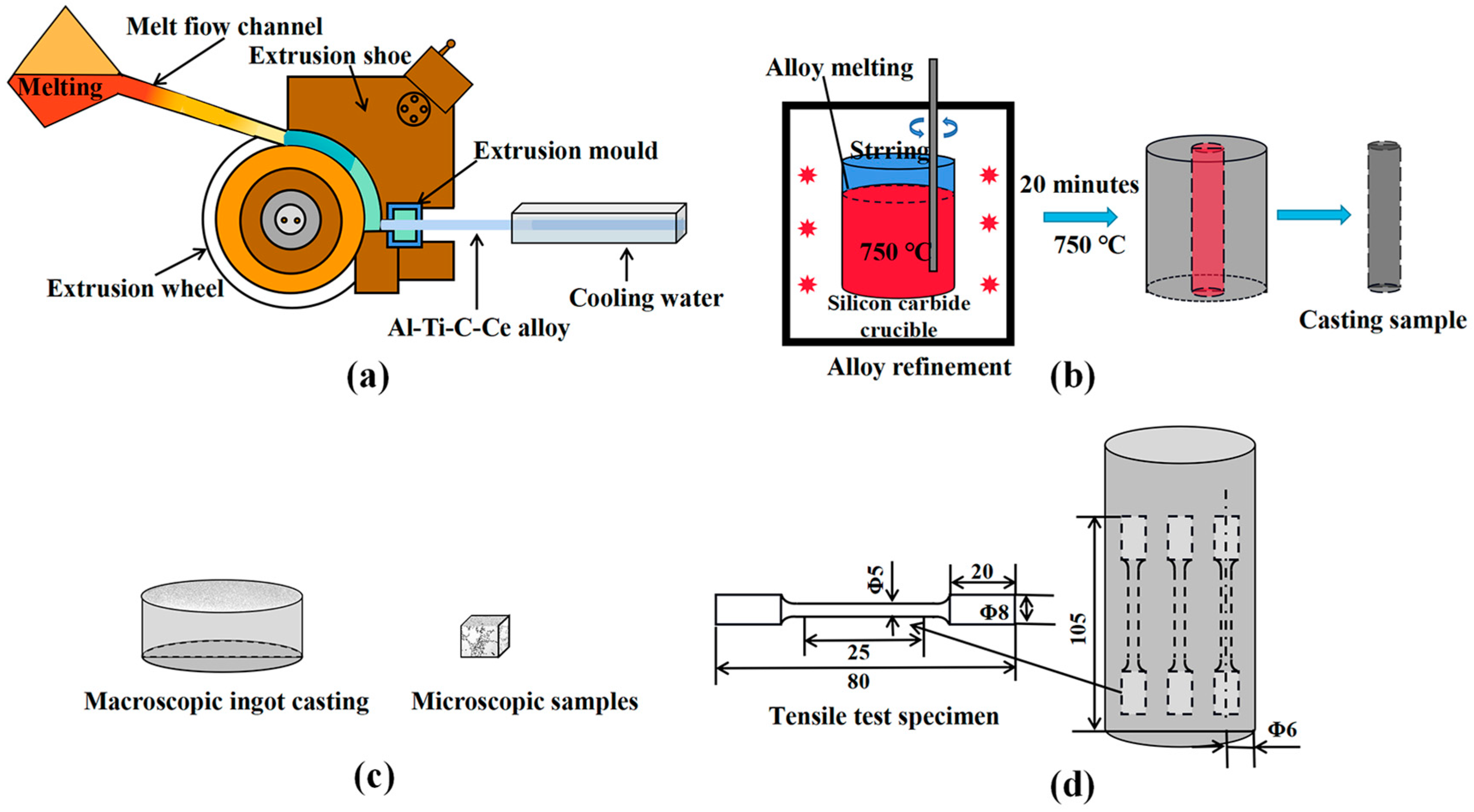


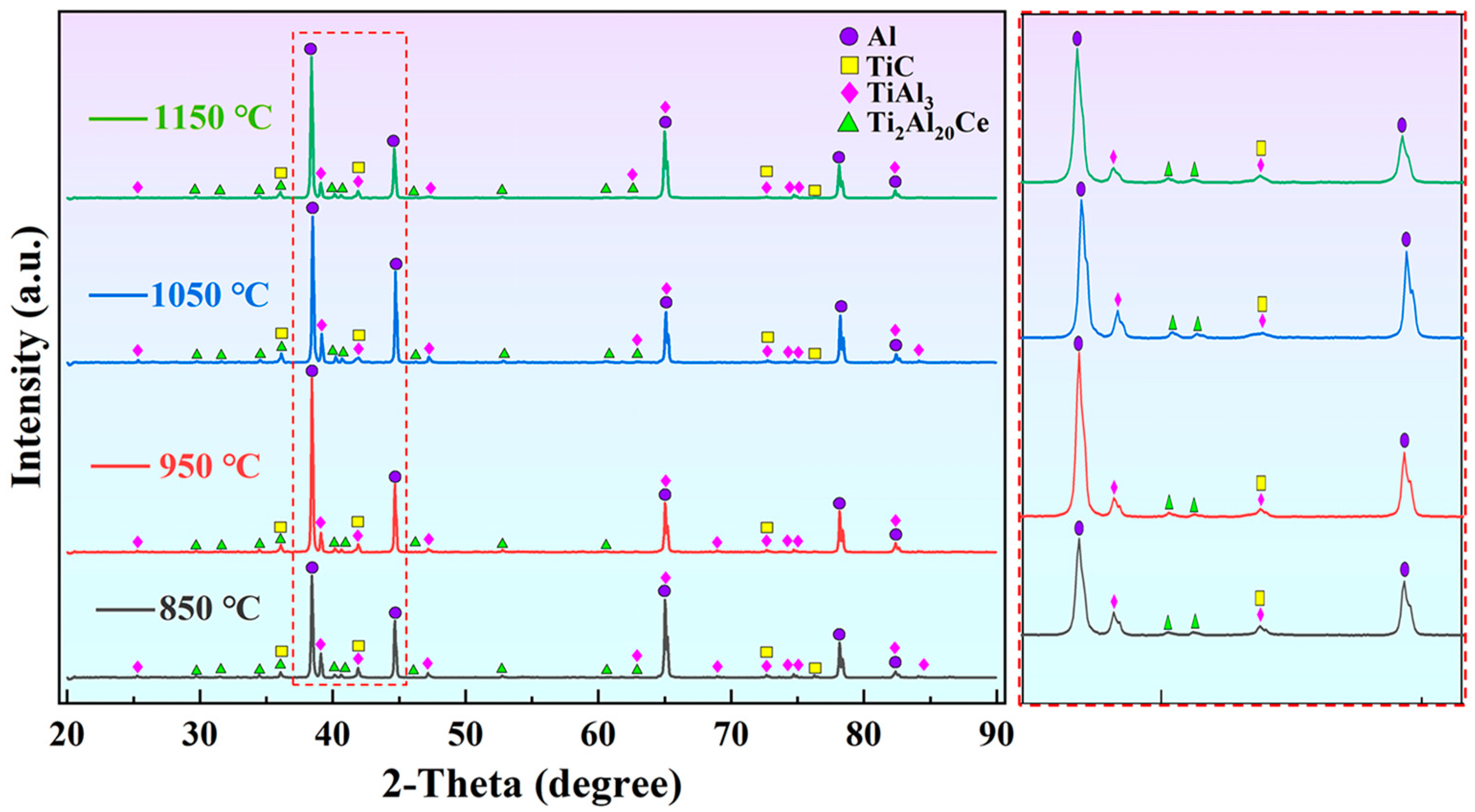

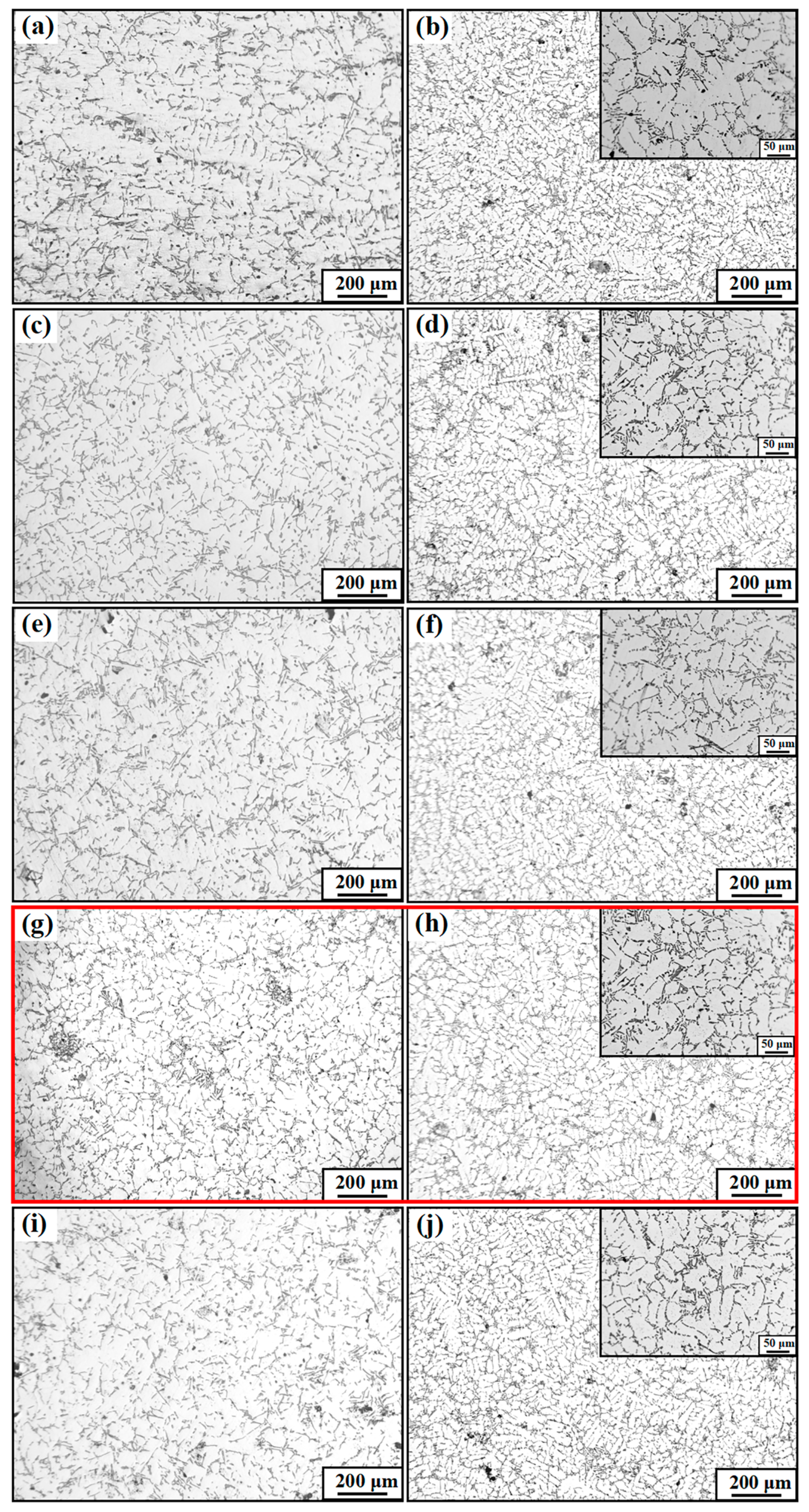
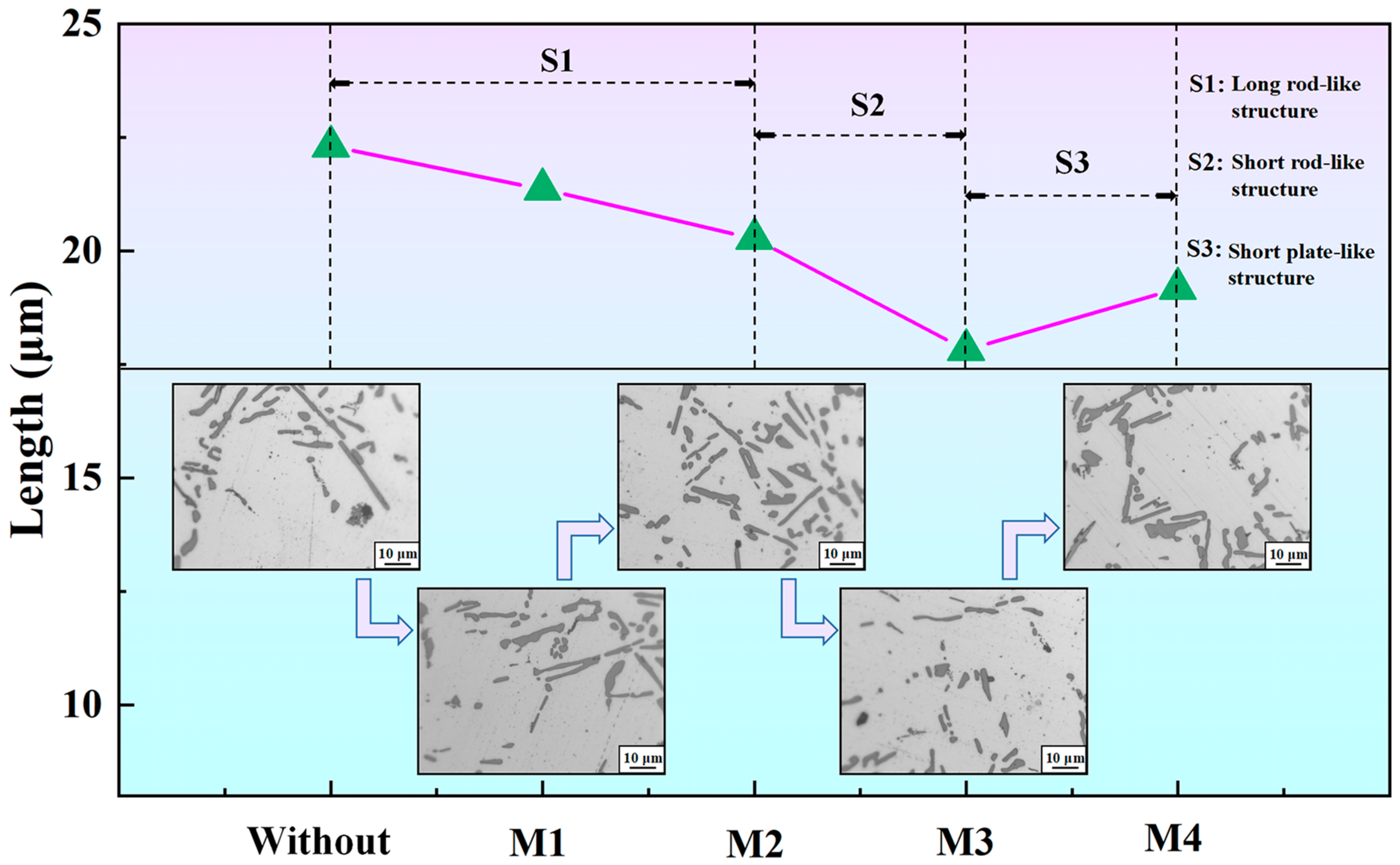
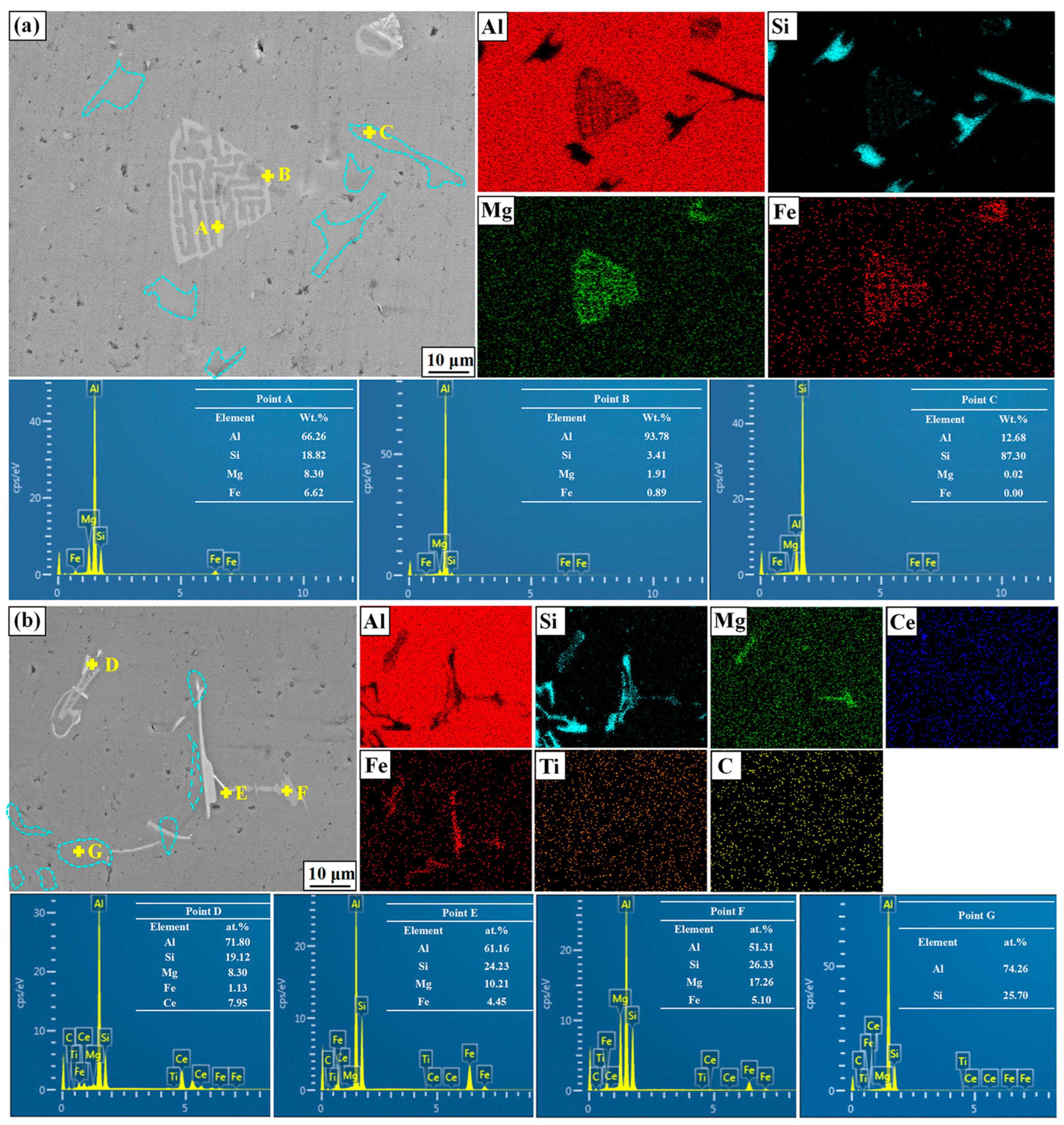
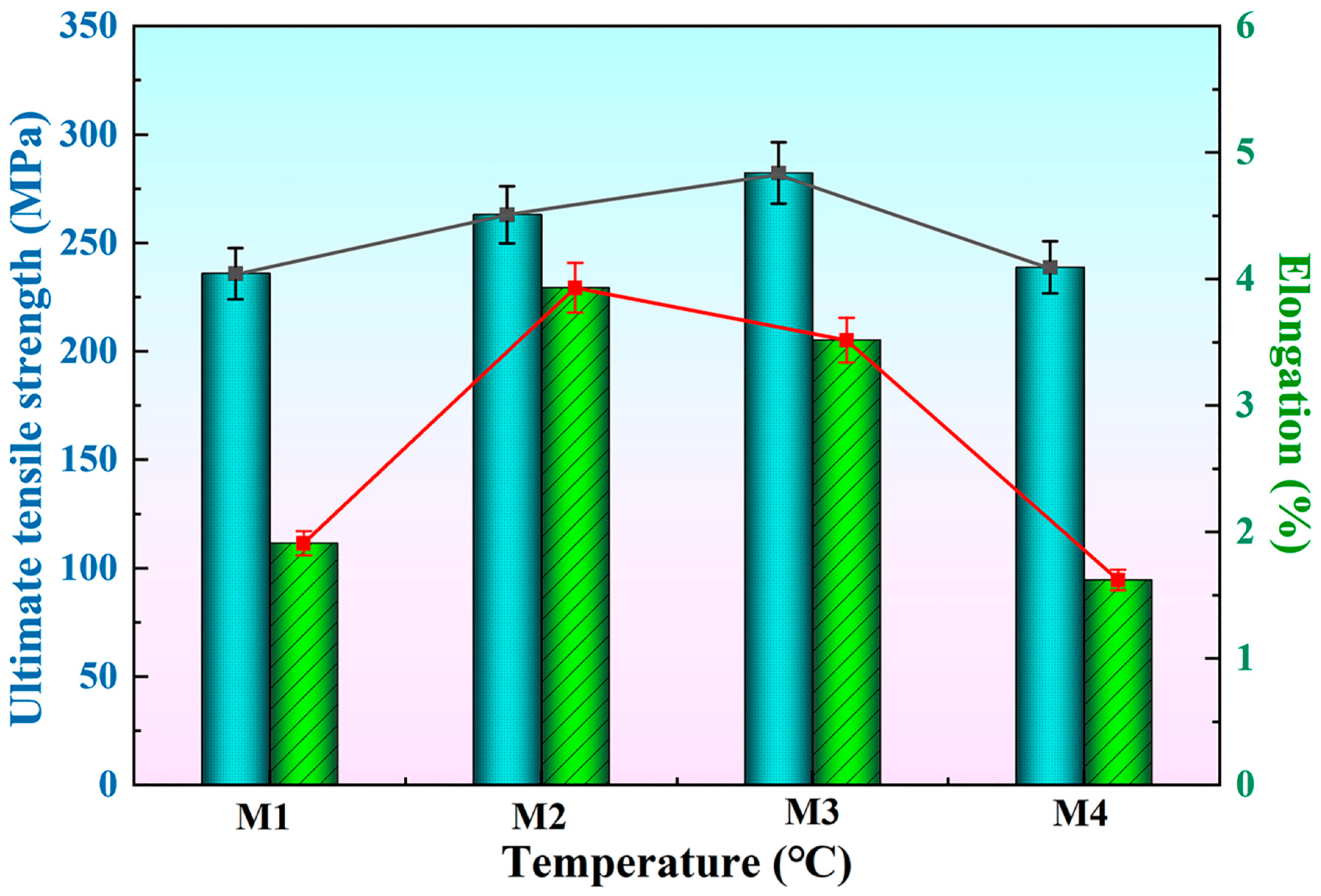

| Grain Refiner | Temperature (°C) | Ti (%) | C (%) | Ce (%) | Al |
|---|---|---|---|---|---|
| Al-5Ti-0.6C-1.0Ce | 850 (M1) | 4.98 | 0.58 | 1.06 | Bal. |
| 950 (M2) | 4.86 | 0.59 | 1.13 | Bal. | |
| 1050 (M3) | 5.07 | 0.65 | 1.04 | Bal. | |
| 1150 (M4) | 4.87 | 0.62 | 1.22 | Bal. |
Disclaimer/Publisher’s Note: The statements, opinions and data contained in all publications are solely those of the individual author(s) and contributor(s) and not of MDPI and/or the editor(s). MDPI and/or the editor(s) disclaim responsibility for any injury to people or property resulting from any ideas, methods, instructions or products referred to in the content. |
© 2023 by the authors. Licensee MDPI, Basel, Switzerland. This article is an open access article distributed under the terms and conditions of the Creative Commons Attribution (CC BY) license (https://creativecommons.org/licenses/by/4.0/).
Share and Cite
Teng, D.; Zhang, G.; Zhang, S.; Li, J.; Guan, R. Mechanical Properties of Refined A356 Alloy in Response to Continuous Rheological Extruded Al-5Ti-0.6C-1.0Ce Alloy Prepared at Different Temperatures. Metals 2023, 13, 1344. https://doi.org/10.3390/met13081344
Teng D, Zhang G, Zhang S, Li J, Guan R. Mechanical Properties of Refined A356 Alloy in Response to Continuous Rheological Extruded Al-5Ti-0.6C-1.0Ce Alloy Prepared at Different Temperatures. Metals. 2023; 13(8):1344. https://doi.org/10.3390/met13081344
Chicago/Turabian StyleTeng, Da, Guangzong Zhang, Shuo Zhang, Junwen Li, and Renguo Guan. 2023. "Mechanical Properties of Refined A356 Alloy in Response to Continuous Rheological Extruded Al-5Ti-0.6C-1.0Ce Alloy Prepared at Different Temperatures" Metals 13, no. 8: 1344. https://doi.org/10.3390/met13081344
APA StyleTeng, D., Zhang, G., Zhang, S., Li, J., & Guan, R. (2023). Mechanical Properties of Refined A356 Alloy in Response to Continuous Rheological Extruded Al-5Ti-0.6C-1.0Ce Alloy Prepared at Different Temperatures. Metals, 13(8), 1344. https://doi.org/10.3390/met13081344







